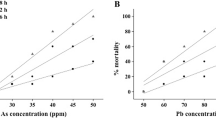Abstract
The present investigation has been conducted to study the effect of different sublethal concentrations of arsenic (5, 10 and 15 mg/L) on the muscle glycogen content in an Indian teleost, Clarias batrachus, during their post-spawning period (October to January).The species were exposed to various arsenic concentrations for six consecutive days i.e.,144 h. Significant differences in average muscle glycogen content were found in the treated male and female C. batrachus specimens. However, significantly higher (P < 0.01) muscle glycogen content was observed in male fish when compared to females in the untreated specimens. Arsenic caused muscle glycogenolysis in both sexes of C. batrachus. The depletions were not always dose (arsenic concentration) and time dependent, although higher concentrations were more glycogenolytic than the lower concentrations. After 96 h of treatment with arsenic, less depletion of muscle glycogen content was recorded in both sexes of fish.



Similar content being viewed by others
References
Ahsan J, Ahsan SN (1983) Influence of multiple ACTH therapy on blood glucose and glycogen content of some organs of Clarias batrachus (Linn.). Biol Bull India 5(2):128–139
Ahsan J, Ahsan SN (1985) A modified technique for quantitative estimation of tissue glycogen. Int J Mendel 1&2:56–57
Ahsan J, Saif S, Kumari B (2006) Studies on the liver and muscle glycogen content in selected air-breathing and non air-breathing Indian teleost. Int J Mendel 23(3–4):133–134 Indian Science Abstract, 44(2), Jan. 16, 2008
Chakraborty D, Samanta G, Mandal BK, Chaudhary TR, Chanda CR, Biswas BK, Dhar RK, Basu GK, Saha KC (1998) Calcutta industrial pollution: Ground water arsenic contamination in a residential area and suffering of people due to industrial effluent discharge-an eight years study report. Curr Sci 7(4):346–360
Garg S, Gupta RK, Jain KL (2008) Sub lethal effects of heavy metals on biochemical composition and their recovery in Indian major carp. J Hazardous Mater XXX:8–16
James R, Sampath K, Alagurathinam S (1996) Effect of lead on respiratory enzyme activity, glycogen, and blood sugar levels of the teleost Oreochromis mossambicus (Peters) during accumulation and depuration. Asian Fish Sci 9:87–100
Kemp A, Adrienne JMKVH (1954) A colorimetric micro method for determination of glycogen in tissue. Biochem J 56:646–648
Leah RT, Envas SJ, Johnson MS (1992) Arsenic in plaice (Pleuronectus platessa) and withing (Merlangius marlangus) from the north east Irish sea. Mar Pollut Bull 24:544–549
Leibson LG, Plisetskaia EM (1968) Effect of insulin blood sugar level and glycogen content in organs of some cyclostomes and fish. Gen Comp Endocrinol 11:381–392
Levesque HM, Moon TW, Campbell PGC, Hontella A (2002) Seasonal variation in carbohydrate and lipid metabolism in yellow Perch (Perca flavescens) chronically exposed to metals in the field. Aquat Toxicol 60:257–267
Malik DS, Sastry KV, Hamilton DV (1998) Effects of zinc toxicity on biochemical composition of muscle and liver in Murrel (C. punctatus). Environ Int 24(4):433–438
Miller DS, Shaw JR, Stanton CR, Barnaby R, Karlson KH, Hamilton JW, Stanton B (2007) MRP2 and acquired tolerance to inorganic arsenic in the kidney of killifish (Fundulus heteroclitus): MRP2 AND ACQUIRED TOLERANCE. Toxicol Sci 25:17324950
Moore JW, Ramamoorthy S (1984) Heavy metals in natural waters. Chapter 2: Arsenic. Springer, New York, pp 4–27
Mukherjee S, Das D, Darbar S, Mukherjee M, Das AS, Mitra C (2004) Arsenic trioxide generates oxidative stress and islet cell toxicity in rabbit. Curr Sci 86(6):854–857
Naidu KA, Abhinender K, Ramamurthi R (1984) Acute effect of mercury toxicity on some enzymes in liver of teleost Sarotherodon mossambicus. Ecotoxicol Environ Saf 8:215–218
Qayyum MA, Shaffi SA (1977) Changes in tissue glycogen of a fresh water catfish Heteropneustes fossilis (Bloch) due to mercury intoxication. Curr Sci 46:652–653
Radhakrishnaiah K, Venkalaramana P, Suresh A, Sivramkrishnam B (1992) Effect of lethal and sub-lethal concentrations of copper on glycolysis in liver and muscle of freshwater teleost fish, Labeo rohita. Ham Ind J Comp Anim Physiol 14:30–33
Reichl FX, Szinicz L, Kreppel H, Forth W (1988) Effect of arsenic on carbohydrate metabolism after single or repeated injection in guinea pigs. J Arch Toxicol 62(6):473–475
Reichl FX, Sznicz L, Kreppel H, Fichtl B, Forth W (1990) Effect of glucose in mice after acute experimental poisoning with arsenic trioxide (As2O3). J Arch Toxicol 64:336–338
Sastry KV, Rao DR (1984) Effects of mercuric chloride on some biochemical and physiological parameters of the fresh water Murrel Channa punctatus. Environ Res 34:343–350
Shaw J, Colbourne J, Davey J, Glaholt S, Hampton T, Chen C, Folt C, Hamilton J (2007) The influence of treatment history on arsenic accumulation and toxicity in the killifish, Fundulus heteroclitus. Environ Toxicol Chem 26(12):2704–2709
Sorensen EMB (1976) Thermal effects of the accumulation of arsenic in green sunfish. Arch Environ Contam Toxicol 4:8–17
Author information
Authors and Affiliations
Corresponding author
Rights and permissions
About this article
Cite this article
Kumari, B., Ahsan, J. Study of muscle glycogen content in both sexes of an Indian teleost Clarias batrachus (Linn.) exposed to different concentrations of Arsenic. Fish Physiol Biochem 37, 161–167 (2011). https://doi.org/10.1007/s10695-010-9427-2
Received:
Accepted:
Published:
Issue Date:
DOI: https://doi.org/10.1007/s10695-010-9427-2




